Box jellyfish, scientifically known as Cubozoa, are a fascinating group of invertebrates that belong to the phylum Cnidaria. There are currently 51 described species, however as they are wide ranging and occupy tropical and subtropical coastal waters around the world, there are likely more species yet to be discovered. They are commonly found in regions such as the Indo-Pacific, Australia, the Pacific Islands, the Caribbean, the Gulf of Mexico and South Africa.
Named after their box-shaped bell, these jellyfish are globally recognised for their potent venomous sting. Their bell is transparent and composed of a soft, gelatinous substance, with approximately 15 highly venomous tentacles hanging from each corner. At the base of each tentacle is a sensory organ called a rhopalium, which contains balance organs and eyes, enabling them to detect light and navigate their surroundings.

Highly capable swimmers, the box jellyfish’s propelling movements are coordinated by an advanced nervous system, allowing it to move rapidly at roughly 7 km/h, or 4 knots, faster than any other class of jellyfish. Their size ranges widely from the coin-sized Irukandji (Carukia barnesi) to the gargantuan Flecker’s sea wasp (Chironex fleckeri) with a bell of over 30 centimetres in diameter and tentacles of 3 metres in length. Despite considerable variations in size across the class, most species of box jellyfish are extremely venomous. Stings can cause intense pain, skin irritation, cardiovascular problems, and in severe cases, even death. It is important to exercise caution when swimming in areas where box jellyfish are known to occur.
As carnivorous predators, they primarily feed on small fish and invertebrates such as shrimp. In contrast to drifting as do true jellyfish, box jellyfish actively pursue their prey. Their tentacles are equipped with thousands of specialised cells called cnidocytes that contain harpoon-like structures called nematocysts. When prey comes into contact with the tentacles, the nematocysts are triggered, injecting venom into the prey and immobilising it. Box jellyfish then use their oral arms to maneuver the captured prey into their mouth for digestion. Despite their venomous tentacles, box jellyfish are commonly preyed upon by green sea turtles, which have been observed to be unaffected by the stinging cells.
Box jellyfish are considered to be abundant, and not listed as a species of conservation concern by the International Union for Conservation of Nature. Perhaps the only point of potential concern for the box jellyfish could arise from the influence of overfishing resulting in a depleted prey base, and climate change shifting oceanic conditions. Jellyfish are largely influenced by water temperature, light and salinity, and experts hypothesise that a shift in seasons holds the potential to influence jellyfish abundance.
Dating back 500 million years (250 million years before the age of the dinosaurs!), jellyfish are a fascinating component of natural history. The box jellyfish’s remarkable efficiency comes as no surprise when considering their prehistoric origin, making them a fascinating time capsule of the age of our oceans. Snorkeling in Cape Town offers a unique opportunity to explore the underwater world, including encounters with fascinating creatures like the box jellyfish. While caution is necessary due to their potent sting, their advanced biology and hunting techniques make them all the more intriguing.



